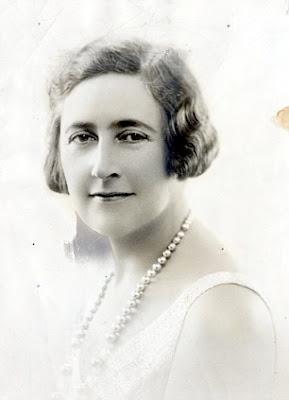 Annie Haynes
Annie Haynes
Book Review by Sylvia D: Haynes was born in Leicestershire in 1865. By 1908 she was living in London with the daughter of an eminent orthopedic surgeon who introduced her to literary and feminist circles, the members of whom gave Haynes their support. She wrote newspaper serial novels followed by 12 mysteries published between 1923 and 1930, the penultimate appearing posthumously and the last probably completed by Agatha Christie or Dorothy L Sayers. She is probably best known for her Inspector Stoddart and her Inspector Furnival mystery series.
The Bungalow Mystery, published in 1923 as a stand-alone novel, is told mainly from the point of view of a stock doctor character – pipe-smoking Roger Lavington who wears tweeds and has a spinster aunt to keep house for him. He addresses women of a lower class as ‘my good woman’.
His reluctant rehearsing for the village play is interrupted by the arrival of the wild-eyed and distraught housekeeper from the bungalow next-door babbling that her master is dead. The baddie of the novel is this dead neighbour, a reclusive artist called Maximilian von Reinhart (note the German name) whom everyone described as a brute and a bad man. He has been murdered and Lavington discovers another wild-eyed, distraught woman hiding behind the curtains who pleads for his help. Touched by her plight, he sends her to his own house just as the stolid village constable, PC Frost, arrives and discovers close to the body a long suede glove and a diamond ring.
To protect her, Lavington persuades the girl to impersonate his actress cousin who at the last minute had been prevented by illness from coming down from London to take part in the play. When Frost comes to Lavington’s house to interrogate him, he is suspicious of the girl but has to accept Lavington’s word that she is his cousin. The next day she does take part in the play having miraculously learned all her lines in twenty-four hours despite being so distraught the night before. By the following morning she has disappeared. That night there is a train crash in which a woman answering to the girl’s description has been killed. Case apparently closed.
Jump forward two years and Lavington has become the medical attendant to his former school friend, Sir James Courtenay, who was seriously injured in the said train crash. It emerges that the woman on the train was not the girl of the night of the murder, so the police start to hunt for the real killer.
The story progresses via a tangled web of characters each of whom has a reason to suspect one of the others. The police team includes now ex-Constable Frost who is good at lurking in the bushes disguised improbably as an artist, a not very bright, flower-growing inspector and a retired detective who has set up his own detective agency and tries to be the enigmatic thinker and deviser of theories. They turn out to be on the wrong trail.
All the other characters act in what they think are the best interests of the person they believe has committed the murder as they have reasons to protect them. This creates myriad red herrings and potentially damaging conclusions, and the reader is kept guessing. Sir James even claims he was the murderer in order to protect his fiancée whom he believed was the suspect. This leads to his arrest and trial. However, they are all wrong in their assumptions. The mystery is solved by a retired judge who appeared fleetingly at the beginning of the story and only reappears right at the end. There has to be a love element, and Dr Lavington finally gets his girl.
A Sunday Times reviewer of the novel felt that it was ‘not only a crime story of merit, but also a novel which will interest readers to whom mystery for its own sake has little appeal’. The novel does have the feel of a Victorian melodrama with ‘quivering lips’, ‘tear-laden eyelashes’, and ‘ghastly white faces’ galore, whilst male characters indulge in ‘short, hard laughs’, gnashes of teeth and much striding around. There’s a particularly melodramatic incident when a strange old tenant on his estate warns Sir James, ‘Listen, there is trouble coming to you – bitter, black trouble. But – and if you will walk warily – light will arise out of darkness; sweet will spring from bitter.” This is almost religious in tone. There are ridiculous coincidences and mistaken identities. However, I felt I had struck lucky in that the story is well-plotted and Haynes’ writes well. She is particularly good at period detail.
Haynes suffered from painful rheumatoid arthritis and died at the age of 63 in 1929. During the years of her success, she and Agatha Christie were the only female mystery writers published by The Bodley Head. She seems to have been rated more highly than Dorothy L Sayers at the time. However, after her death she and her novels were soon forgotten and have only recently been rediscovered by Dean Street Press. Had she lived longer she may have become the fifth “Queen of Crime”.
